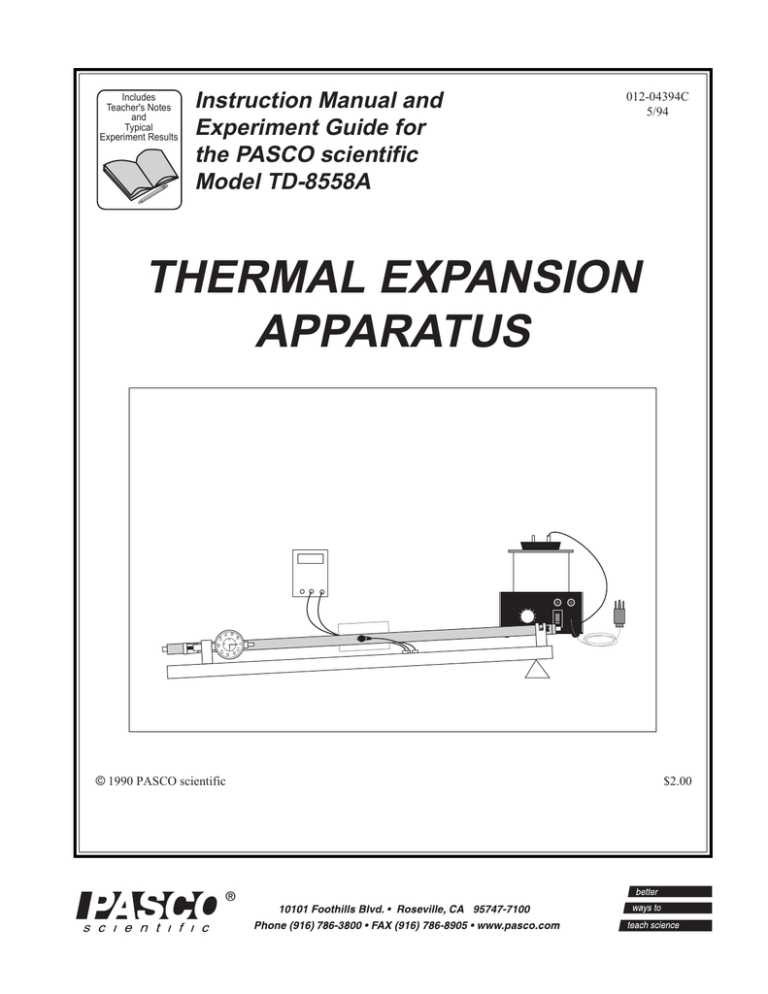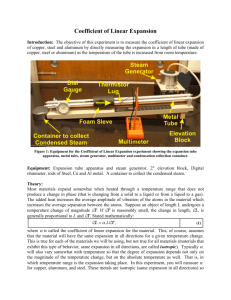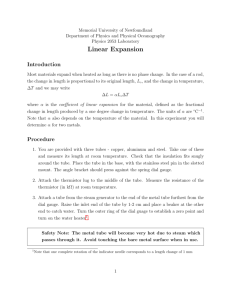
Includes
Teacher's Notes
and
Typical
Experiment Results
Instruction Manual and
Experiment Guide for
the PASCO scientific
Model TD-8558A
012-04394C
5/94
THERMAL EXPANSION
APPARATUS
30
0
15
0
10
30
20
60 50 40
90
70
80
© 1990 PASCO scientific
$2.00
012-04394C
Thermal Expansion Apparatus
Table of Contents
Section
Page
Copyright, Warranty and Equipment Return .................................................. ii
INTRODUCTION:
Equipment .................................................................................................. 1
Additional Equipment Required ................................................................ 1
Notes on Temperature Measurement ......................................................... 1
Accepted Values for Coefficient of Thermal Expansion........................... 2
Changing Tubes ......................................................................................... 2
Replacement Parts ..................................................................................... 2
EXPERIMENT:
Measuring the Coefficient of Linear Expansion for Copper, Steel, and
Aluminum:
Introduction ......................................................................................... 3
Procedure ............................................................................................. 3
Data and Calculations .......................................................................... 4
Questions ............................................................................................. 5
Thermistor Conversion Table: ............................................................. 5
Teacher’s Guide ............................................................................................... 1
Technical Support ............................................................................................ 3
i
Thermal Expansion Apparatus
012-04394C
Copyright, Warranty and Equipment Return
Please—Feel free to duplicate this manual
subject to the copyright restrictions below.
Equipment Return
Copyright Notice
Should the product have to be returned to PASCO
scientific for any reason, notify PASCO scientific by
letter, phone, or fax BEFORE returning the product.
Upon notification, the return authorization and
shipping instructions will be promptly issued.
The PASCO scientific Model TD-8558A Thermal
Expansion Apparatus manual is copyrighted and all
rights reserved. However, permission is granted to
non-profit educational institutions for reproduction of
any part of this manual providing the reproductions
are used only for their laboratories and are not sold for
profit. Reproduction under any other circumstances,
without the written consent of PASCO scientific, is
prohibited.
NOTE: NO EQUIPMENT WILL BE
ACCEPTED FOR RETURN WITHOUT AN
AUTHORIZATION FROM PASCO.
ä
Limited Warranty
When returning equipment for repair, the units
must be packed properly. Carriers will not accept
responsibility for damage caused by improper
packing. To be certain the unit will not be
damaged in shipment, observe the following rules:
PASCO scientific warrants this product to be free
from defects in materials and workmanship for a
period of one year from the date of shipment to the
customer. PASCO will repair or replace, at its option,
any part of the product which is deemed to be defective in material or workmanship. This warranty does
not cover damage to the product caused by abuse or
improper use. Determination of whether a product
failure is the result of a manufacturing defect or
improper use by the customer shall be made solely by
PASCO scientific. Responsibility for the return of
equipment for warranty repair belongs to the customer. Equipment must be properly packed to prevent
damage and shipped postage or freight prepaid.
(Damage caused by improper packing of the equipment for return shipment will not be covered by the
warranty.) Shipping costs for returning the equipment,
after repair, will be paid by PASCO scientific.
➀ The packing carton must be strong enough for the
item shipped.
➁ Make certain there are at least two inches of
packing material between any point on the
apparatus and the inside walls of the carton.
➂ Make certain that the packing material cannot shift
in the box or become compressed, allowing the
instrument come in contact with the packing
carton.
ii
Address:
PASCO scientific
10101 Foothills Blvd.
Roseville, CA 95747-7100
Phone:
FAX:
email:
web:
(916) 786-3800
(916) 786-3292
techsupp@pasco.com
www.pasco.com
012-04394C
Thermal Expansion Apparatus
Introduction
Introduction
Additional Equipment Required
The PASCO Model TD-8558A Thermal Expansion
Apparatus provides easy and accurate measurements
of the coefficient of linear expansion for steel, copper,
and aluminum.
In addition to the TD-8558A Thermal Expansion
Apparatus, the following items are needed to perform
the experiment:
➀ A source of steam or hot water, such as the PASCO
Model TD-8556 Steam Generator.
To make the measurement, the steel, copper, or
aluminum tube is placed on the expansion base. The
length of the tube is measured at room temperature,
then steam is passed through it. The expansion of the
metal is measured with 0.01 mm resolution using the
built-in dial-gauge. Temperatures are measured to
within 0.5 °C using a thermistor attached to the center
of the tube. If you wish to investigate the expansion of
the metals at additional temperatures, hot or cold water
can be passed through the tubes.
➁ A digital ohmmeter such as PASCO Model SE9589 to measure the thermistor resistance. Leads
should have banana plug connectors, such as
PASCO Model SE-9750 or SE-9751 Patch Cords.
➂ A small object to raise the end of the expansion
base approximately 2-inches and a container to
catch the water as it drains out of the tube.
➃ If additional data points are desired you will also
need: a source of hot or cold water.
Complete step by step instructions and a data sheet for
results are provided on the following pages.
Notes on Temperature Measurement
Equipment
A thermistor's resistance varies reliably with temperature. The resistance can be measured with an ohmmeter, and converted to a temperature measurement using
the conversion table provided on the expansion base
and also on the back page of this manual. Although
the relationship between temperature and resistance is
not linear, a linear approximation can be accurately
used to interpolate between table data points with an
accuracy of approximately ±0.2 °C.
Your TD-8558A Thermal Expansion Apparatus
includes:
• A 70 cm long expansion base with a built-in dial
gauge and thermistor.
➤ NOTE: The dial gauge can be removed or
repositioned by loosening the screw on the dial
gauge mounting block.
The thermistor used to measure the tube temperature is
embedded in the thermistor lug. Once thermal equilibrium has been reached, the heat is highly uniform
along the length of the tube. The foam insulator is
used to inhibit heat loss through the thermistor lug so
the lug temperature closely follows the tube temperature. The insulator does not have any appreciable
effect on the local temperature of the tube itself.
• Three metal tubes — steel, copper (99.5% Cu,
0.5% Te), and aluminum (98.9% Al, 0.7% Mg,
0.4% Si): 5/8-inch outside diameter with 1/4inch outside diameter connectors. Each tube has a
thumbscrew for attaching the thermistor lug.
• A foam insulator to avoid heat loss at the thermistor connection point.
• Thermoplastic elastometer tubing with 1/4" I.D.
1
Thermal Expansion Apparatus
012-04394C
Accepted Values for Coefficient of
Thermal Expansion
Material
a ( x10-6/∞C )
Copper
17.6
Steel
11.3 to 13.5
Aluminum
23.4
Replacement Parts
The following parts can be ordered from
PASCO scientific.
Item
Changing Tubes
➤ Caution:
Tube
When changing tubes be careful
not to pull the wires off the
thermistor. The thumbscrew must be completely removed
before the thermistor
can be lifted off the
threaded rod.
Thermistor
Thumbscrew
2
PASCO Part #
mod. Thermistor (100 kΩ)
150-03140
Al Tube Assy
003-04413
Cu Tube Assy
003-04412
Steel Tube Assy
003-04414
Foam Insulator
648-03100
Dial Gauge
620-050
012-04394C
Thermal Expansion Apparatus
Experiment: Measuring the Coefficient of Linear
Expansion for Copper, Steel, and Aluminum
Introduction
Most materials expand somewhat when heated through a temperature range that does not
produce a change in phase. The added heat increases the average amplitude of vibration of
the atoms in the material which increases the average separation between the atoms.
Suppose an object of length L undergoes a temperature change of magnitude ∆T. If ∆T is
reasonably small, the change in length, ∆L, is generally proportional to L and ∆T. Stated
mathematically:
∆L = αL ∆T;
where α is called the coefficient of linear expansion for the material.
For materials that are not isotropic, such as an asymmetric crystal for example, a can have a
different value depending on the axis along which the expansion is measured.
a can also vary somewhat with temperature so that the degree of expansion depends not
only on the magnitude of the temperature change, but on the absolute temperature as well.
In this experiment, you will measure α for copper, aluminum, and steel. These metals are
isotropic so that a need only be measured along one dimension. Also, within the limits of
this experiment, a does not vary with temperature.
Procedure
➀ Measure L, the length of the copper tube at room temperature. Measure from the inner edge
of the stainless steel pin on one end, to the inner edge of the angle bracket at the other end
(see Figure 1). Record your results in Table 1.
➁ Mount the copper tube in the expansion base as shown in Figure 2. The stainless steel pin
on the tube fits into the slot on the slotted mounting block and the bracket on the tube
presses against the spring arm of the dial
gauge.
➤ NOTE: Slide or push the tube to one side of
the slide support. Drive the thumbscrew
against the pin until the tube can no longer be
moved. Use this as your reference point.
➂ Use one of the provided
thumbscrews to attach
the thermistor lug to the
threaded hole in the
middle of the copper
tube. The lug should be
aligned with the axis of
the tube, as shown in
Figure 2, so there is
maximum contact
L
Figure 1 Measuring Tube Length
Bracket on tube
Stainless steel pin
Dial Gauge Spring Arm
Slotted bracket
Figure 2 Equipment Setup (Top View)
3
Thumbscrew
Thermal Expansion Apparatus
012-04394C
between the lug and the tube.
➃ Place the foam insulator over the thermistor lug as shown in Figure 3.
➄ Plug the leads of your ohmmeter into the banana plug connectors labeled THERMISTOR in the center of the expansion base.
Copper Tube
Foam Insulator
➅ Measure and record Rrm, the resistance of the thermistor at room
temperature. Record this value in the table.
➆ Use tubing to attach your steam generator to the end of the
copper tube. Attach it to the end farthest from the dial gauge.
➇ Use a book or a block of wood to raise the end of the expansion
base at which steam enters the tube—a few centimeters is
sufficient. This will allow any water that condenses in the tube
to drain out. Place a container under the other end of the tube to
catch the draining water.
Thermistor Lug
Banana Connectors
Figure 3 Thermistor Attachment
➈ Turn the outer casing of the dial gauge to align the zero point on the scale with the long
indicator needle. As the tube expands, the indicator needle will move in a counterclockwise
direction.
➉ Turn on the steam generator. As steam begins to flow, watch the dial gauge and the ohmmeter.
When the thermistor resistance stabilizes, record the resistance (Rhot) in Table 1. Also record
the expansion of the tube length (∆L) as indicated by the displacement of the indicator on the
dial gauge. (Each increment on the dial gauge is equivalent to 0.01 mm of tube expansion.)
Note that ∆L is the difference betwen the dial gauge readings.
➤ Repeat the experiment for the steel and aluminum tubes.
Data and Calculations
TABLE 1 Data and Calculations
DATA
L (mm)
Rrm (Ω)
CALCULATIONS
∆L (mm)
Rhot (Ω)
Trm (C°)
Thot (C°)
Copper
Steel
Aluminum
➀ Use the Conversion Table at the end of this manual, or the one on the top of the expansion
base, to convert your thermistor resistance measurements, Rrm and Rhot, into temperature
measurements, Trm and Thot. Record your results in the table.
4
∆T (C°)
012-04394C
Thermal Expansion Apparatus
➁ Calculate ∆T = Thot – Trm. Record the result in the table.
➂ Using the equation ∆L = αL ∆T, calculate a for copper, steel, and aluminum.
αCu =
__________________
αsteel =
__________________
αAl =
__________________
Questions
➀ Look up the accepted values for the linear expansion coefficient for copper, steel, and
aluminum. Compare these values with your experimental values. What is the percentage
difference in each case? Is your experimental error consistently high or low?
➁ On the basis of your answers in question 1, speculate on the possible sources of error in
your experiment. How might you improve the accuracy of the experiment?
➂ From your result, can you calculate the coefficients of volume expansion for copper,
aluminum, and steel? (i.e. ∆V = αvolV ∆T)
THERMISTOR CONVERSION TABLE:
Temperature versus Resistance
Res.
(Ω)
351,020
332,640
315,320
298,990
283,600
269,080
255,380
242,460
230,260
218,730
207,850
197,560
187,840
178,650
169,950
161,730
153,950
146,580
139,610
133,000
126,740
120,810
115,190
109,850
104,800
100,000
Temp.
(°C)
0
1
2
3
4
5
6
7
8
9
10
11
12
13
14
15
16
17
18
19
20
21
22
23
24
25
Res.
(Ω)
95,447
91,126
87,022
83,124
79,422
75,903
72,560
69,380
66,356
63,480
60,743
58,138
55,658
53,297
51,048
48,905
46,863
44,917
43,062
41,292
39,605
37,995
36,458
34,991
33,591
32,253
Temp.
(°C)
26
27
28
29
30
31
32
33
34
35
36
37
38
39
40
41
42
43
44
45
46
47
48
49
50
51
5
Res.
(Ω)
Temp.
(°C)
30,976
29,756
28,590
27,475
26,409
25,390
24,415
23,483
22,590
21,736
20,919
20,136
19,386
18,668
17,980
17,321
16,689
16,083
15,502
14,945
14,410
13,897
13,405
12,932
12,479
12,043
52
53
54
55
56
57
58
59
60
61
62
63
64
65
66
67
68
69
70
71
72
73
74
75
76
77
Res.
(Ω)
11,625
11,223
10,837
10,467
10,110
9,767.2
9,437.7
9,120.8
8,816.0
8,522.7
8,240.6
7,969.1
7,707.7
7,456.2
7,214.0
6,980.6
6,755.9
6,539.4
6,330.8
6,129.8
5,936.1
5,749.3
5,569.3
Temp.
(°C)
78
79
80
81
82
83
84
85
86
87
88
89
90
91
92
93
94
95
96
97
98
99
100
Thermal Expansion Apparatus
012-04394C
Notes
6
012-04394C
Thermal Expansion Apparatus
Teacher’s Guide
Experiment: Measuring the Coefficient of Linear Expansion for Copper, Steel and Aluminum
Notes on Procedure
Notes on Questions
➉ If you allow too much time to elapse before making
your length measurement, the guage rod will absorb
heat, which will decrease the measurement. The
thermistor takes longer to reach equilibrium than
the tube, though; so you must allow a fair amount
of time for your temperature measurement to stabilize. To get the best results despite these problems,
record the maximum change in length recorded by
the guage and the minimum resistance recorded by
the ohmmeter.
➀ The values for Copper and Aluminum are within
2% of the accepted values, and are both low. The
value for steel was within the accepted range. (Steel
has a wide range of linear expansion coefficients,
due to varying composition.)
➁ Answers will vary
➂ αvol ≈ (αlinear)3
Data and Calculations
TABLE 1 Data and Calculations
DATA
CALCULATIONS
L (mm)
Rrm (Ω)
∆L (mm)
Rhot (Ω)
Trm (C°)
Thot (C°)
∆T (C°)
Copper
700
99,100
0.88
5,910
25.1
98.0
72.9
Steel
700
99,300
0.61
5,970
25.1
97.9
72.8
Aluminum
700
102,000
1.19
5,880
24.5
98.5
74.0
αCu = 17.25 x 10-6 /C°
αsteel = 11.97 x 10-6 /C°
αAl= 23.1 x 10-6 /C°
1
Thermal Expansion Apparatus
012-04394C
Notes
2
012-04394C
Thermal Expansion Apparatus
Technical Support
Feed-Back
Contacting Technical Support
If you have any comments about this product or this
manual please let us know. If you have any suggestions on alternate experiments or find a problem in the
manual please tell us. PASCO appreciates any customer feed-back. Your input helps us evaluate and
improve our product.
Before you call the PASCO Technical Support staff it
would be helpful to prepare the following information:
• If your problem is computer/software related, note:
Title and Revision Date of software.
Type of Computer (Make, Model, Speed).
To Reach PASCO
Type of external Cables/Peripherals.
• If your problem is with the PASCO apparatus, note:
For Technical Support call us at 1-800-772-8700 (tollfree within the U.S.) or (916) 786-3800.
Title and Model number (usually listed on the label).
Approximate age of apparatus.
A detailed description of the problem/sequence of
events. (In case you can't call PASCO right away,
you won't lose valuable data.)
If possible, have the apparatus within reach when
calling. This makes descriptions of individual parts
much easier.
• If your problem relates to the instruction manual,
note:
Part number and Revision (listed by month and year
on the front cover).
Have the manual at hand to discuss your questions.
3





